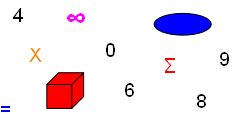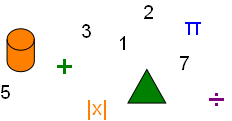



Linear Equations


Linear Equations are mathematical expressions of anything that proceeds without varying, shifting or altering direction along its track or path.
They are first-degree polynomials and graph as straight lines. Their variables do not appear in the denominator of a fraction and have an exponent of 1:
4x − 12 = 16 is an example.
If a linear equation solution is two variables it provides Cartesian Coordinates, (x, y), to graph a straight line that is sloping, horizontal or vertical. Multiple lines on a Cartesian coordinate system diagram can be parallel or intersecting. A straight line requires at least 2 coordinates, each specifies a unique point on that line.
Sometimes “Rectangular” is used instead of Cartesian as; Rectangular Coordinate System, Rectangular Coordinates.
Single Variable Linear Equations
Are solved by isolating one variable onto one side of the equation:
2(3y − 1) = 4(y − 5)
6y − 2 = 4y − 20
6y − 4y = 2 − 20
2y = −18
y = −9
2x/4 = 3(x − 4)/2 =
4 (2x / 4) = 4 [3 (x − 4) / 2]
2x = 2 [3 (x − 4)]
2x = 6x − 24
x = (6x − 24) / 2
x = 3x − 12
x − 3x = −12
−2x = −12
x = 6
0.4 x + 0.37 = 0.21x − 4
100 (0.4 x + 0.37) = 100 (0.21x − 4)
40x + 37 = 21x − 400
40x − 21x = −400 − 37
19x = −437
x = −23
Literal Equations
If an equation has more than one variable; solve for any one variable by isolating that variable onto one side of the equation. Many formulas are Literal Equations.
4c + 2x = 5b
2x = 5b − 4c
x = (5b − 4c) / 2
2 (2x − b) = 2c / 3
6 (2x − b) = 2c
12x − 6b = 2c
x = (6b + 2c) / 12
x = 2 (3b + c) / 12
x = (3b + c) / 6
Linear Equation Word Problems
Creating equations to solve linear problems.
A formula for velocity is: V = K + 32t; where V is velocity, K is energy and t is time:
V − K = 32t
(V − K) / 32 = t
Cut a pipe that is 21 feet long so that one piece is twice the length of the other:
p + 2p = 21
3p = 21
p = 7
The shorter pipe is 7 feet. The longer piece is 14 feet.
The sum of two numbers is 17. Find the numbers if twice the smaller is 4 more than the larger:
x + 2x − 4 = 17
3x = 21
x = 7 is the smaller number.
2x − 4 = 14 − 4 = 10 is the larger number.
Help: First break the problem into components then solve it;
State the equation as f(g) + f(h) = 17 then define f(g) and f(h).
f(g) = x, the smaller number.
f(h) = 2x − 4, second number is four less twice the smaller number.
f(g) + f(h) = 17 = x + 2x − 4
Copyright © DigitMath.com
All Rights Reserved.